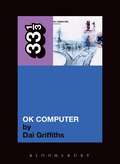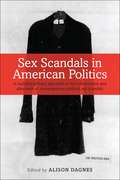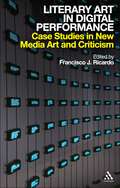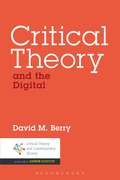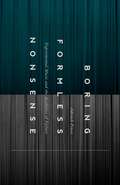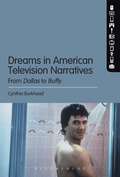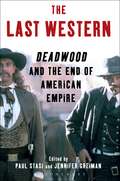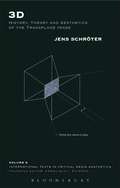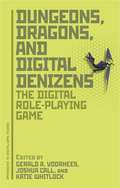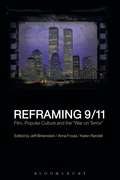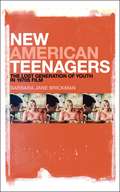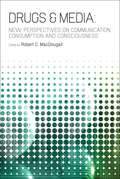- Table View
- List View
Radiohead's OK Computer (33 1/3)
by Dai GriffithsSeemingly granted 'classic album' status within days of its release in 1997, OK Computer transformed Radiohead from a highly promising rock act into The Most Important Band in the World – a label the band has been burdened by (and has fooled around with) ever since. Through close musical analysis of each song, Dai Griffiths explores the themes and ideas that have made this album resonate so deeply with its audience, and argues that OK Computer is one of the most successfully realized CD albums so far created.
Sex Scandals in American Politics: A Multidisciplinary Approach to the Construction and Aftermath of Contemporary Political Sex Scandals
by Alison DagnesA collection of essays that examine the construction, disgrace, and consequences of political sex scandals from various academic disciplines.
Digimodernism: How New Technologies Dismantle the Postmodern and Reconfigure Our Culture
by Alan KirbyA bold new challenge to postmodern theory The increasing irrelevance of postmodernism requires a new theory to underpin our current digital culture. Almost without anybody noticing, a new cultural paradigm has taken center stage, displacing an exhausted and increasingly marginalized postmodernism. Alan Kirby calls this cultural paradigm digimodernism, a name comprising both its central technical mode and the privileging of fingers and thumbs inherent in its use. Beginning with the Internet (digimodernism's most important locus), then taking into account television, cinema, computer games, music, radio, etc., Kirby analyzes the emergence and implications of these diverse media, coloring our cultural landscape with new ideas on texts and how they work. This new kind of text produces distinctive forms of author and reader/viewer, which, in turn, lead to altered notions of authority, 'truth' and legitimization. With users intervening physically in the creation of texts, our electronically-dependent society is becoming more involved in the grand narrative. To clarify these trends, Kirby compares them to the contrasting tendencies of the preceding postmodern era. In defining this new cultural age, the author avoids both facile euphoria and pessimistic fatalism, aiming instead to understand and thereby gain control of a cultural mode which seems, as though from nowhere, to have engulfed our society. With new technologies unfolding almost daily, this work will help to categorize and explain our new digital world and our place in it, as well as equip us with a better understanding of the digital technologies that have a massive impact on our culture.
Artie Shaw: His Life and Music
by John WhiteArtie Shaw led one of America's most accomplished big bands during the 1930s and 1940s, and has sold over 100 million records. An enigmatic figure, Shaw frequently tired of the music business, often forsaking it for extended periods. This study offers a narrative account and analytical assessment of the achievements and concerns of this hugely important musician.
Magazine Movements: Women's Culture, Feminisms and Media Form
by Laurel ForsterAll women's magazines are not the same: content, outlook, and format combine to shape publications quite distinctively. While magazines in general have long been understood as a significant force in women's lives, many critiques have limited themselves to discussions of mainstream printed publications that engage with narrowly stereotypical representations of femininity. Looking at a range of women's magazines (Cooperative Correspondence Club and Housewife) and magazine programmes (Woman's Hour and Houseparty), Magazine Movements not only extends our definition of a magazine, but most importantly, unearths the connections between women's cultures, specific magazines and the implied reader. The author first outlines the existing field of magazine studies, and analyzes the methodologies employed in accessing and assessing the cultural competence of magazines. Each chapter then provides a case study of a different kind of magazine: different in media form or style of presentation or audience connection, or all three. Forster not only extends our definition of a magazine, but most importantly, unearths the connections between women's cultures, specific magazines and the implied reader. In this way, fresh insights are provided into the long-standing importance of the magazine to the variety of feminisms on offer in Britain, from the mid twentieth century to the present day.
Literary Art in Digital Performance: Case Studies in New Media Art and Criticism
by Francisco J. RicardoLiterary Art in Digital Performance examines electronic works of literary art, a category integrating the visual+textual including interactive poetry, narrative computer games, filmic sculpture and projective art. Each case study/chapter is followed by a 'post-chapter' dialogue between editor and author - providing further entry points for theoretical analysis.
Cybertext Poetics: The Critical Landscape of New Media Literary Theory (International Texts in Critical Media Aesthetics)
by Markku EskelinenEqually interested in what is and what could be, Cybertext Poetics combines ludology and cybertext theory to solve persistent problems and introduce paradigm changes in the fields of literary theory, narratology, game studies, and digital media. The book first integrates theories of print and digital literature within a more comprehensive theory capable of coming to terms with the ever-widening media varieties of literary expression, and then expands narratology far beyond its current confines resulting in multiple new possibilities for both interactive and non-interactive narratives. By focusing on a cultural mode of expression that is formally, cognitively, affectively, socially, aesthetically, ethically and rhetorically different from narratives and stories, Cybertext Poetics constructs a ludological basis for comparative game studies, shows the importance of game studies to the understanding of digital media, and argues for a plurality of transmedial ecologies.
Critical Theory and the Digital (Critical Theory and Contemporary Society)
by David M. BerryThis Critical Theory and Contemporary Society volume offers an original analysis of the role of the digital in today's society. It rearticulates critical theory by engaging it with the challenges of the digital revolution to show how the digital is changing the ways in which we lead our politics, societies, economies, media, and even private lives. In particular, the work examines how the enlightenment values embedded within the culture and materiality of digital technology can be used to explain the changes that are occurring across society.Critical Theory and the Digital draws from the critical concepts developed by critical theorists to demonstrate how the digital needs to be understood within a dialectic of potentially democratizing and totalizing technical power. By relating critical theory to aspects of a code-based digital world and the political economy that it leads to, the book introduces the importance of the digital code in the contemporary world to researchers in the field of politics, sociology, globalization and media studies.
Advertising and Reality: A Global Study of Representation and Content
by Amir HetsroniAdvertising and Reality: A Global Study of Representation and Content offers, for the first time, an extensive study of the way our life is represented in advertising. Leading scholars from different countries, who specialize in marketing communication and media studies, review and analyze different advertising contents and give us a truly cross-cultural view of the matter. Among the contents that are thoroughly discussed throughout the book one finds sexuality, violence, family activities, gender roles, vocations, minorities roles, periodical reconstruction and more. This book provides an up-to-date picture of the way modern life is portrayed in the most popular format of marketing communication worldwide.
The Environmental Documentary: Cinema Activism in the 21st Century
by John A. DuvallThe Environmental Documentary provides the first extensive coverage of the most important environmental films of the decade, including their approach to their topics and their impacts on public opinion and political debate. While documentaries with themes of environmental activism date back at least to Pare Lorenz's films of the 1930's, no previous decade has produced the number and quality of films that engage environmental issues from an activist viewpoint. The convergence of high profile issues like climate change, fossil fuel depletion, animal abuse, and corporate malfeasance has combined with the miniaturization of high quality recording equipment and the expansion of documentary programming, to produce an unprecedented number of important and influential documentary productions.The text examines the processes of production and distribution that have produced this explosion in documentaries. The films range from a high-profile Hollywood production with theatrical distribution like An Inconvenient Truth, to shorter independently produced films like The End of Suburbia that have reached a small audience of activists through video distribution, interviews with many of the filmmakers, and word of mouth.
Boring Formless Nonsense: Experimental Music and the Aesthetics of Failure
by Eldritch PriestBoring Formless Nonsense intervenes in an aesthetics of failure that has largely been delimited by the visual arts and its avant-garde legacies. It focuses on contemporary experimental composition in which failure rubs shoulders with the categories of chance, noise, and obscurity. In these works we hear failure anew. We hear boredom, formlessness, and nonsense in a way that gives new purchase to aesthetic, philosophical, and ethical questions that falter in their negative capability. Reshaping debates on failure as an aesthetic category, eldritch Priest shows failure to be a highly dubious concept. The book frames recent experimental composition as a deviant kind of sound art whose affective and formal elements reflect on current issues in contemporary culture, and offers analyses of musical works and performance practices that are rarely heard, let alone considered as significant cultural phenomena - showing the role that obscurity and the esoteric have in articulating current cultural realities. Ambitious in content and experimental in its approach, Boring Formless Nonsense will challenge and fracture your views on failure, creativity, and experimental music.
Dreams in American Television Narratives: From Dallas to Buffy
by Cynthia BurkheadDreams in Television Narratives is the first comprehensive analysis of one of American television's most frequently utilized tropes, the dream. From its beginning, television has been a storytelling medium. Whether delivered to a live audience or played out on a sound stage, narratives and those who write them have always been the crux of the television program. While film can claim a long history of scholarly inquiry into the connection between film and dreams, no comprehensive research exists on the subject of television dreams. Locating its primary function as narrative, the author uses examples from American sitcoms and dramatic programs, analyzing the narrative functions of dreams using, as its frame, Carl Jung's narrative stages of the dream: exposition, development, culmination, and conclusion. While television dreams are analyzed throughout, case studies of the television programs The Sopranos and Buffy the Vampire Slayer are included to show in detail how dreams function throughout a television series. Includes a compendium of over 1000 television episodes that include dreams, a valuable tool for any television scholar or enthusiast.
The Spectralities Reader: Ghosts and Haunting in Contemporary Cultural Theory
by Esther Peeren Maria del Pilar BlancoThe Spectralities Reader is the first volume to collect the rich scholarship produced in the wake of the “spectral turn” of the early 1990s, which saw ghosts and haunting conjured as compelling analytical and methodological tools across the humanities and social sciences. Surveying the past twenty years from an interdisciplinary and cross-cultural perspective, the Reader displays the wide range of concerns spectrality, in its diverse elaborations, has been called upon to elucidate. The disjunctions produced by globalization, the ungraspable quality of modern media, the convolutions of subject formation (in terms of gender, race, and sexuality), the elusiveness of spaces and places, and the lingering presences and absences of memory and history have all been reconceived by way of the spectral. A primer for the wide readership engaged with cultural interpretations of ghosts and haunting that go beyond the confines of the fictional and supernatural, The Spectralities Reader includes twenty-five groundbreaking texts by prominent contemporary thinkers, from Jacques Derrida and Gayatri Spivak to Avery Gordon and Arjun Appadurai, as well as a general introduction and six section introductions by the editors.
The Last Western: Deadwood and the End of American Empire
by Paul Stasi Jennifer GreimanPerhaps the most sophisticated and complex of shows in HBO's recent history, Deadwood has surprisingly little coverage in our current scholarship. Grounding contemporary anxieties about race and class, domesticity and American exceptionalism in its nineteenth-century setting, Deadwood revises our understanding of a formative period for the American nation through a re-examination of one of the main genres through which this national story has been transmitted: the Western. With contributions from scholars in American studies, literature, and film and television studies, The Last Western situates Deadwood in the context of both its nineteenth-century setting and its twenty-first-century audience. Together, these essays argue for the series as a provocative meditation on both the state and historical formation of U.S. empire, examining its treatment of sovereign power and political legitimacy, capital accumulation and dispossession, racial and gender identities, and social and family structures, while attending to the series' peculiar and evocative aesthetic forms. What emerges from this collection is the impressive range of Deadwood's often contradictory engagement with both nineteenth and twenty-first century America.
Early '70s Radio: The American Format Revolution
by Kim SimpsonEarly '70s Radio focuses on the emergence of commercial music radio "formats," which refer to distinct musical genres aimed toward specific audiences. This formatting revolution took place in a period rife with heated politics, identity anxiety, large-scale disappointments and seemingly insoluble social problems. As industry professionals worked overtime to understand audiences and to generate formats, they also laid the groundwork for market segmentation. Audiences, meanwhile, approached these formats as safe havens wherein they could re-imagine and redefine key issues of identity. A fresh and accessible exercise in audience interpretation, Early '70s Radio is organized according to the era's five prominent formats and analyzes each of these in relation to their targeted demographics, including Top 40, "soft rock", album-oriented rock, soul and country. The book closes by making a case for the significance of early '70s formatting in light of commercial radio today.
3D: History, Theory and Aesthetics of the Transplane Image (International Texts in Critical Media Aesthetics)
by Jens SchröterThere is a blind spot in recent accounts of the history, theory and aesthetics of optical media: namely, the field of the three-dimensional, or trans-plane, image. It has been widely used in the 20th century for very different practices - military, scientific and medical visualization - precisely because it can provide more spatial information. And now in the 21st century, television and film are employing the method even more. Appearing for the first time in English, Jens Schroeter's comprehensive study of the aesthetics of the 3D image is a major scholarly addition to this evolving field. Citing case studies from the history of both technology and the arts, this wide-ranging and authoritative book charts the development in the theory and practice of three-dimensional images. Discussing and analyzing the transformation of the socio-cultural and technological milieu, Schroeter has produced a work of scholarship that combines impressive historical scope with contemporary theoretical arguments.
The Mood of Information: A Critique of Online Behavioural Advertising
by Andrew McStayThe Mood of Information explores advertising from the perspective of information flows rather than the more familiar approach of symbolic representation. At the heart of this book is an aspiration to better understand contemporary and nascent forms of commercial solicitation predicated on the commodification of experience and subjectivity. In assessing novel forms of advertising that involve tracking users' web browsing activity over a period of time, this book seeks to grasp and explicate key trends within the media and advertising industries along with the technocultural, legal, regulatory and political environment online behavioural advertising operates within. Situated within contemporary scholarly debate and interest in recursive media that involves intensification of discourses of feedback, personalization, recommendation, co-production, constructivism and the preempting of intent, this book represents a departure from textual criticism of advertising to one based on exposition of networked means of inferring preferences, desires and orientations that reflect ways of being, or moods of information.
Rethinking U.S. Labor History: Essays on the Working-Class Experience, 1756-2009
by Daniel J. Walkowitz Donna T. Haverty-StackeRethinking U.S. Labor History provides a reassessment of the recent growth and new directions in U.S. labor history. Labor History has recently undergone something of a renaissance that has yet to be documented. The book chronicles this rejuvenation with contributions from new scholars as well as established names. Rethinking U.S. Labor History focuses particularly on those issues of pressing interest for today's labor historians: the relationship of class and culture; the link between worker's experience and the changing political economy; the role that gender and race have played in America's labor history; and finally, the transnational turn.
Investigative Journalism in China: Journalism, Power, and Society
by Jingrong TongIn the framework of democratic societies, investigative journalism is deemed as serving the public interest, helping maintain a healthy public sphere and helping to hold power into account. The ideals of a democratic society justify the idea and practice of investigative journalism. Alternately, modern China runs an authoritarian system of the one-party rule, so where does the idea of investigative journalism fit in? Why can investigative journalism appear in such an authoritarian society and with what characteristics? Investigative Journalism in China examines the four aspects of Chinese investigative journalism (the Idea of investigative journalism and its comparison against Western contexts; the Development/Influence; Reporters and their work; and the Impacts on society), by using empirical data from Dr. Jingrong Tong's fieldwork at two newsrooms (the Southern Metropolitan Daily and the Dahe Daily) in 2006, 73 in-depth-interviews conducted from 2004-2008, and the analysis of internal and public documents and media cases in order to accurately survey the field and put it in context.
Dungeons, Dragons, and Digital Denizens: The Digital Role-Playing Game (Approaches to Digital Game Studies #Vol. 1)
by Gerald A. Voorhees Joshua Call Katie WhitlockDungeons, Dragons, and Digital Denizens is a collection of scholarly essays that seeks to represent the far-reaching scope and implications of digital role-playing games as both cultural and academic artifacts. As a genre, digital role playing games have undergone constant and radical revision, pushing not only multiple boundaries of game development, but also the playing strategies and experiences of players. Divided into three distinct sections, this premiere volume captures the distinctiveness of different game types, the forms of play they engender and their social and cultural implications. Contributors examine a range of games, from classics like Final Fantasy to blockbusters like World of Warcraft to obscure genre bending titles like Lux Pain. Working from a broad range of disciplines such as ecocritism, rhetoric, performance, gender, and communication, these essays yield insights that enrich the field of game studies and further illuminate the cultural, psychological and philosophical implications of a society that increasingly produces, plays and discourses about role playing games.
No Time To Think: The Menace of Media Speed and the 24-hour News Cycle
by Howard Rosenberg Charles S. FeldmanAn eviscerating look at the state of journalism in the age of the 24 hour news cycle by a Pulitzer Prize-winning television critic and a veteran news correspondent. No Time To Think focuses on the insidious and increasing portion of the news media that, due to the dangerously extreme speed at which it is produced, is only half thought out, half true, and lazily repeated from anonymous sources interested in selling opinion and wild speculation as news. These news item can easily gain exposure today, assuming a life of their own while making a mockery of journalism and creating casualties of cool deliberation and thoughtful discourse. Much of it is picked up gratuitously and given resonance online or through CNN, Fox News, MSNBC and other networks, which must, in this age of the 24-hour news cycle, "feed the beast." In dissecting this frantic news blur, No Time to Think breaks down a number of speed-driven blunders from the insider perspective of Charles Feldman, who spent 20 years as a CNN correspondent, as well as the outsider perspective of Howard Rosenberg, who covered the coverage for 25 years as TV critic for The Los Angeles Times. No Time to Think demonstrates how today's media blitz scrambles the public's perspective in ways that potentially shape how we think, act and react as a global society. The end result effects not only the media and the public, but also the government leaders we trust to make carefully considered decisions on our behalf. Featuring interviews ranging from former NBC News anchor Tom Brokaw to internet doyenne Arianna Huffington to PBS stalwart Jim Lehrer to CNN chief Jonathan Klein to a host of former presidential press secretaries and other keen-eyed media watchers, this incisive work measures lasting fallout from the 24-hour news cycle beginning in 1980 with the arrival of CNN, right up to the present.
Prince's Sign O' the Times (33 1/3)
by Michaelangelo MatosOne of the greatest double albums of the vinyl era, Sign O' the Times shows Prince at his peak. Here, Michaelangelo Matos tells the story of how it emerged from an extraordinary period of creativity to become one of the landmark recordings of the 1980s. He also illustrates beautifully how - if a record is great enough and lucky enough to hit you at the right time - it can change your way of looking at the world.
Reframing 9/11: Film, Popular Culture and the "War on Terror"
by Anna Froula Karen Randell Jeff BirkensteinSeptember 11th, 2001 remains a focal point of American consciousness, a site demanding ongoing excavation, a site at which to mark before and after "everything" changed. In ways both real and intangible the entire sequence of events of that day continues to resonate in an endlessly proliferating aftermath of meanings that continue to evolve. Presenting a collection of analyses by an international body of scholars that examines America's recent history, this book focuses on popular culture as a profound discursive site of anxiety and discussion about 9/11 and demystifies the day's events in order to contextualize them into a historically grounded series of narratives that recognizes the complex relations of a globalized world. Essays in Reframing 9/11 share a collective drive to encourage new and original approaches for understanding the issues both within and beyond the official political rhetoric of the events of the "The Global War on Terror" and issues of national security.
New American Teenagers: The Lost Generation of Youth in 1970s Film
by Barbara Jane BrickmanTaking a closer look at teen film in the 1970s, New American Teenagers uncovers previously marginalized voices that rework the classically male, heterosexual American teenage story. While their parents' era defined the American teenager with the romantic male figure of James Dean, this generation of adolescents offers a dramatically altered picture of transformed gender dynamics, fluid and queered sexuality, and a chilling disregard for the authority of parent, or more specifically, patriarchal culture. Films like The Rocky Horror Picture Show, Halloween, and Badlands offer a reprieve from the 'straight' developmental narrative, including in the canon of study the changing definition of the American teenager. Barbara Brickman is the first to challenge the neglect of this decade in discussions of teen film by establishing the subversive potential and critical revision possible in the narratives of these new teenage voices, particularly in regards to changing notions of gender and sexuality.
Drugs & Media: New Perspectives on Communication, Consumption, and Consciousness
by Robert C. MacDougallWe have developed into a culture that is over-reliant upon pharmaceutical and recreational drugs; where drugs are incessantly advertised and promoted to us via our mass media. Like drugs, communication media alter the way we interact with the world; they direct our attention in various ways, sometimes enabling certain behaviors and experiences, and prohibiting others.  The contributors to this cutting-edge collection apply media ecological concepts to consider how drugs function as communication technologies; literally media in and for the human sensorium. In these essays, drugs are considered as communication media in a practical sense, not merely in the metaphorical way they tend to be discussed in the popular press. Media and drugs are thus conceived as communicative tools that enhance and/or inhibit physical, social and symbolic experience - our ways of seeing and being in the world. Drugs & Media: New Perspectives on Communication, Consumption and Consciousness is the first book to examine this parallel, promoting a critical awareness of the significant impact of drugs and media on individuals, society and our wider human culture. Â
